As part of its efforts to take the environment and biodiversity into account, Thermocoax introduced its teams to the concept of insect hotel.
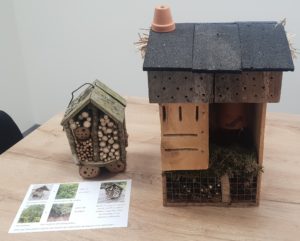
Background
The concept of the multi-dwelling insect hotel was invented by a German gardener interested in entomology. At the end of the 1980s, insect hotels were already being built in Germany and France, but this type of construction was not widely known.
This type of structure was inspired by entomological study devices developed by biologists for the study of certain species. In the 19th century, in England, the existence of “bee boxes”, intended for the observation of these insects, is documented in botanical gardens.
In France, in the 1970s, specific devices, equipped with slits, were used to study a ladybird summering at altitude on Mont Ventoux.
In the early 2000s, insect hotels were becoming increasingly popular in France as the general public became aware of the urgent need to protect biodiversity. Numerous models are now on the market.
Usefulness
Insect hotels are an undeniable educational tool for raising awareness of the importance of insect fauna. However, in ecological terms, they are only of significant interest in areas where Nature is no longer present or is too restricted: urbanised areas and gardens that have been severely “tidied up”. In these areas, insects no longer find the natural habitats they need, and insect hotels can provide a refuge.
Bundles of hollow or pithy stems and logs with drilled holes are effective in providing shelter for solitary wasps and bees. Hotels for butterflies, lacewings or ladybirds are generally not very effective as these insects still manage to find places to spend the winter: ivy, dead leaves, cellars or garden sheds.
Insect hotels can only provide a back-up solution and it is preferable to encourage gardeners and green space managers to keep areas of wild plants on their land, to create piles of dead leaves or wood… And of course, to ban all insecticides and herbicides.
Biological and naturalistic background
In their living environment, small invertebrates such as insects can be preyed upon by other animals in food chains.
They may therefore try to camouflage themselves from their predators in their natural habitats (tall grass, holes in trunks, under stones or dead wood, etc.)
They may also be forced to protect themselves from the physical conditions of their habitat, depending on the season (light, dryness, cold, etc.).
Some invertebrates can be useful to gardeners by eating crop pests but also by pollinating fruit trees and other plants. They are known as beneficial insects for crops.
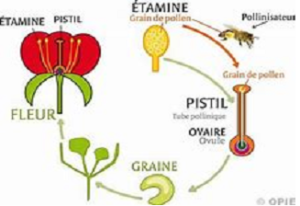 Illustration 1: Diagram showing the important role of insects in the growth of flowers and fruits. (Illustration source: OPIE)
Illustration 1: Diagram showing the important role of insects in the growth of flowers and fruits. (Illustration source: OPIE)
In gardens at home or at work, we can encourage insect diversity and apply the concept of biological pest control to protect our plants rather than using insecticides that are harmful to the environment. The idea is to attract and encourage predators of animals that destroy plants in the garden. For example, ladybirds or lacewings can devour the aphids that consume the sap of crops.
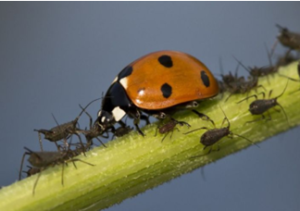 Illustration 2: An adult ladybird can eat several dozen aphids a day. A ladybird larva can eat up to 150 aphids a day. (Illustration source: sciencesetavenir.fr)
Illustration 2: An adult ladybird can eat several dozen aphids a day. A ladybird larva can eat up to 150 aphids a day. (Illustration source: sciencesetavenir.fr)
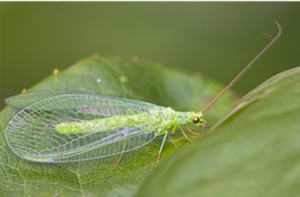 Illustration 3: A lacewing larva can eat hundreds of aphids before reaching adulthood. (Illustration source: pepinieres-huchet.com)
Illustration 3: A lacewing larva can eat hundreds of aphids before reaching adulthood. (Illustration source: pepinieres-huchet.com)
As beneficial insects for crops, we may like to attract insects such as ladybirds and lacewings to our gardens.
We can encourage them to visit our gardens:
– by planting locally adapted plants, for example yarrow which attracts ladybirds, and simply by keeping an area of ‘wild’ grass (wild plants that grow as they please, yet are sometimes called ‘weeds’).
– by building an insect hotel that will serve as a shelter for them.
In order to encourage the presence of insects in your garden, it is therefore important to adopt the two complementary approaches described above: keeping an area of wild grass (so that they can feed and hide) and building an insect hotel (so that they can settle in permanently).
How to build an insect hotel ?
Before building an insect hotel, it is important to know which species to attract, the benefits they will bring to your garden and, of course, the materials that could attract them.
The table below, which is not exhaustive, shows some of the insect species that are useful in gardens and what materials are likely to attract them. The materials, which are most often recommended for the construction of insect hotels, can be used for this type of project.
Here is a link to a fairly thorough video that outlines the steps involved in building a multi-chambered hotel of the type shown in Illustration 5 which will attract all kinds of insects : https://www.youtube.com/watch?v=EINP3vZL46Y#t=536.175313
 Table 1: Overview of the role of insects and the materials that can attract them to your garden.
Table 1: Overview of the role of insects and the materials that can attract them to your garden.
Nevertheless, it would appear that two simple types of insect hotel—dried stem bundles and logs with drilled holes—are just as effective as the multi-chamber model shown in illustration 5. For example, earwigs will always find a crack to take refuge in, even in the most unnatural garden. A butterfly hotel will often be less attractive to butterflies than a thick ivy… This underlines the importance of having a suitable space in terms of the plants in the garden and the way it is managed. Schematically, the “tidier” a garden is, the less hospitable it is to insects.
The “dried stem bundle” hotel
In nature, many hymenopterans (solitary wasps, solitary bees) use hollow stems to build their nests. The bundle of stems, which may or may not be set in a wooden frame, is a simple hotel using stems of different sizes: hollow (bamboo, umbellifers) or full of pith (bramble, elder). The two types of stems will attract different species. The diameter of the pithy stems will be 1 to 2 cm, the hollow stems between a few millimetres and 1 cm.
How to build and install the hotel:
1) Cut the hollow stems with a knot at one end so that there is only one entrance/exit. Gather the stems into a bundle of 10 to 20 sections of about 15 cm in length.
2) Tie these bundles with wire or strong string, especially if they are not set in a wooden frame.
3) Set up the bunches in a wooden frame or in the middle of the vegetation on stakes about 1 m long. This insect hotel should be set up between 50 cm and 2 m high, facing east or south in order to give it good sunlight in the morning. A wall protected by a roof overhang, for example, is suitable for this hotel, provided that the orientation is respected.
It is a good idea to replace this type of hotel every year, especially those with pith stems. This is because the pith can only be dug out once, unlike hollow stems which can be reoccupied two years in a row.
 Illustration 6: Dried stem bundle. (Illustration source: magasinsaveve.be)
Illustration 6: Dried stem bundle. (Illustration source: magasinsaveve.be)
The “log with drilled holes” hotel
In nature, dead or dying trees provide an important food resource for beetle larvae, which burrow into the trees to feed, after which adults will emerge.
The burrows created in this way can be inhabited by a solitary bee or wasp, which builds the cells for its larvae.
In view of the scarcity of dead trees in nature, which is nowadays “excessively tidied up”, it may be useful to offer insects alternative nesting sites by installing a “drilled wood log” hotel.
How to build and install the hotel:
1) In a hardwood log or cube, drill holes of different diameters (2 to 8 mm), of varying depths. Be careful that the drill bit does not go through the piece of wood so that only one entrance/exit is left.
2) The drilled piece of wood can then be installed in a wooden frame or hung 1 or 2 m high in a weatherproof location. It should preferably face south or south-east so that it gets sunlight in the morning and is quickly adopted by insects.
Over the years, it will be necessary to replace these hotels because the holes will eventually become clogged with debris. In the spring, the pieces of wood can be placed at the base of the hedge to allow any remaining tenants to leave. The wood will finish decomposing naturally and will be beneficial to woodborers.
 Illustration 7: log with drilled holes (Illustration source: gerbeaud.com)
Illustration 7: log with drilled holes (Illustration source: gerbeaud.com)
As a conclusion, various types of insect hotels can be considered, from the simplest (a bundle of dried stems or a log with drilled holes) to the most elaborate (hotels featuring several chambers and built with various materials). This gives employees a degree of freedom depending on their creativity or the amount of DIY time they wish to devote to the project.
In any case, certain simple rules of construction (materials chosen, size, etc.) and installation (location, orientation, etc.) must still be respected in order to optimise the chances of insects being able to live there. It should be noted that an insect hotel can be installed at any time of the year, but it may take some time before it is inhabited. Lastly, the installation of insect hotels must be coupled with the establishment and conservation of favourable flora (native species hedges, areas of wild and honey-producing plants), which is already envisaged by Thermostat.
For inspiration, see below some insect hotels designed and built by schoolchildren. Some have chosen to use slate to cover their hotel, others have added wire mesh to keep the materials inside the frame.
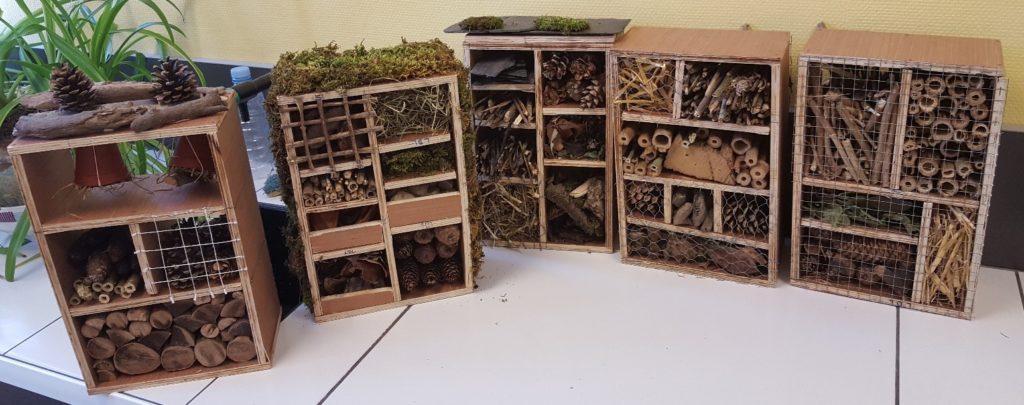 Illustration 8: Insect hotels made by schoolchildren. (Source: Yohann Guillaume)
Illustration 8: Insect hotels made by schoolchildren. (Source: Yohann Guillaume)


 Illustration 1: Diagram showing the important role of insects in the growth of flowers and fruits. (Illustration source: OPIE)
Illustration 1: Diagram showing the important role of insects in the growth of flowers and fruits. (Illustration source: OPIE)





